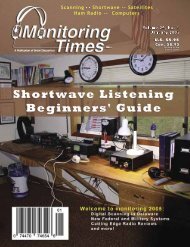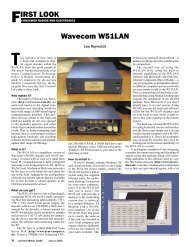RIGHT-click here - Monitoring Times
RIGHT-click here - Monitoring Times
RIGHT-click here - Monitoring Times
Create successful ePaper yourself
Turn your PDF publications into a flip-book with our unique Google optimized e-Paper software.
BTHE WORLD OF DOMESTIC BROADCASTING<br />
ROADCAST BANDSCAN<br />
Doug<br />
Smith, W9WI<br />
dougsmith@monitoringtimes.com<br />
http://americanbandscan.blogspot.com<br />
Over-the-air TV in Canada: Going, going, gone?<br />
If you DX TV, <strong>here</strong>’s hoping you logged<br />
plenty of Canadian stations this summer – as<br />
many of the biggest signals are now gone...<br />
The deadline for the shutdown of analog TV<br />
in Canada was last July. Transmitters in Canada’s<br />
largest cities were to be converted to digital or<br />
else closed. Transmitters in rural areas don’t face<br />
a digital conversion mandate; they’re allowed to<br />
continue in analog indefinitely. The Canadian<br />
Broadcasting Corporation – CBC – obtained a<br />
one-year extension for some of its analog transmitters.<br />
That extension ran out at the end of last<br />
month. The CBC has told the government its<br />
remaining analog transmitters would be shut<br />
down at that time. This includes all CBC analog<br />
TV transmitters, not just the ones in markets<br />
mandated to convert to digital. The transmitters<br />
which have already been converted to digital, in<br />
the largest cities, will continue to operate.<br />
CBC’s TV licences are currently up for renewal.<br />
The transmitter closure plan was released<br />
as part of the renewal application, as answers to<br />
several questions the government asked about<br />
the CBC’s over-the-air plans. A few of the points<br />
raised:<br />
- Based on the ratings, the CBC believes 98% of<br />
Canadians either subscribe to cable/satellite<br />
(“BDUs”) or live within the coverage area of<br />
one of the transmitters which have already been<br />
converted to digital.<br />
- The CBC believes the closure of their analog<br />
transmitters will have no effect on advertising<br />
revenue.<br />
- It would cost $10,700,000 per year to maintain<br />
these transmitters.<br />
- It would cost at least $56,000,000 to replace the<br />
obsolete equipment.<br />
- Most of the affected transmitters are at least<br />
25 years old. Satellite gear used to deliver<br />
programming to these transmitters has been<br />
discontinued.<br />
- One of the satellite providers has offered free<br />
local-channel service to viewers who will lose<br />
over-the-air CBC signals.<br />
More than two dozen powerful VHF transmitters<br />
on channels 2-6 are affected; you’ll notice<br />
this during next summer’s skip season. Hundreds<br />
of smaller transmitters are also involved.<br />
❖ And in the U.S....<br />
The FCC has been taking steps to clear<br />
out TV stations, in anticipation of converting<br />
more spectrum from television to land mobile<br />
(i.e., “smartphones”). T<strong>here</strong> have been several<br />
developments in the last few months:<br />
Channel 51 is being cleared. Low-power<br />
Bruce, KA3UIH received this Illinois station on<br />
his car radio near Washington. (Doug Smith)<br />
TV stations have been urged to leave the channel;<br />
many have. In May, a number of applications<br />
appeared in the FCC TV database for stations<br />
with the mysterious callsign “WTB”. WTB is<br />
not, in fact, a callsign, but is the abbreviation<br />
for the FCC’s Wireless Telecommunications<br />
Bureau – the agency that regulates land-mobile<br />
radio. Each of the “WTB” applications precisely<br />
matches the technical parameters of an existing<br />
channel 51 full-power or Class A TV station.<br />
However, each of these applications specified a<br />
different channel. It certainly appears the FCC<br />
intends to order existing TV stations to leave<br />
channel 51 in favor of lower channels.<br />
The Commission has also announced plans<br />
for a “reverse auction” of TV spectrum. Stations<br />
will be asked how much the FCC would need to<br />
pay in order for the station to surrender its channel<br />
and go off the air. The Commission would<br />
buy out the least expensive channels, sell their<br />
spectrum to land-mobile operators, and use some<br />
of the proceeds to pay the bids. (Some of the rest<br />
would go to compensate other stations for the<br />
cost of channel moves; the rest would go to the<br />
U.S. Treasury.)<br />
Of course, any station that sells the FCC its<br />
channel is volunteering to go out of business!<br />
The Commission figures many stations will be<br />
reluctant to do so, so they’re offering another<br />
alternative: channel-sharing. The station that<br />
volunteers to sell its channel doesn’t go off the<br />
air – it agrees to share a channel with another<br />
station. For example, WJKL-TV offers to sell<br />
channel 44 to the government, and then share<br />
channel 38 with WMNO-TV. In return, WMNO-<br />
TV gets half the money the FCC paid for channel<br />
44.<br />
The technology has existed for years. Any of<br />
you who watch over-the-air TV has noticed “subchannels,”<br />
w<strong>here</strong> one broadcaster transmits two<br />
or more programs simultaneously on the same<br />
channel. Here in Nashville, WKRN transmits<br />
ABC programs on channel 2.1, and a continuous<br />
weather channel on 2.2. T<strong>here</strong> is nothing in the<br />
technology that requires both subchannels to be<br />
programmed by the same company. WMNO-TV<br />
could broadcast its existing religious programming<br />
on channel 39.1, while carrying WJKL-<br />
TV’s programming on channel 66.1 on the same<br />
transmitter.<br />
And while all of this proceeds, commentators<br />
are asking whether this removal of TV<br />
spectrum is even necessary. See the URLs in the<br />
sidebar...<br />
❖ New Kinda-DX<br />
publication<br />
Over the years, I’ve learned that many DXers<br />
didn’t just decide one day they were going<br />
to listen for distant radio stations. Many of us<br />
wanted to hear programming that just wasn’t<br />
available from our local stations. In my case, I<br />
was searching FM for<br />
the rapidly-disappearing<br />
(in the 1970s) progressive<br />
rock stations. For<br />
many a DXer, it was the<br />
search for sports that led<br />
to a new hobby.<br />
MT’s own Ken Reitz<br />
has a new e-book out<br />
that will make sports<br />
DXing easier. The 2012<br />
Baseball Listener’s<br />
Guide lists the stations<br />
across North America<br />
which broadcast professional<br />
baseball. The 30<br />
major-league teams are<br />
covered – and so are<br />
the 100+ minor-league<br />
Ken Reitz’s new e-<br />
book: both a way<br />
to enjoy baseball,<br />
and a way to identify<br />
more DX. (Ken<br />
Reitz)<br />
teams. Obviously, baseball fans wishing to keep<br />
track of their favorite team’s competition will be<br />
interested in this publication.<br />
Really, even if you aren’t a baseball fan, you<br />
should take a look. You’re hearing the Minnesota<br />
Twins on AM 1060, but the only 1060 station in<br />
the state says they don’t carry the games? The<br />
Guide will show which station in a rare state is<br />
carrying this game.<br />
54 MONITORING TIMES August 2012
















